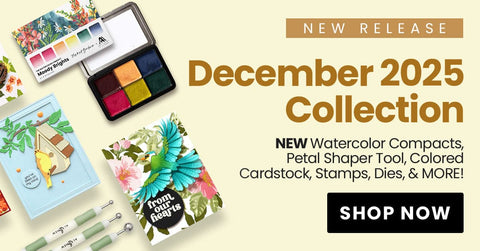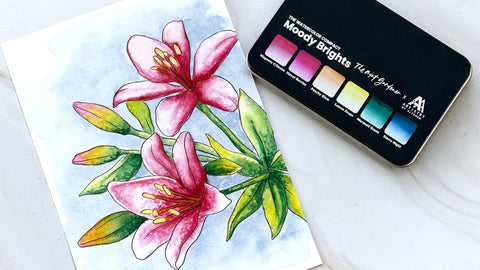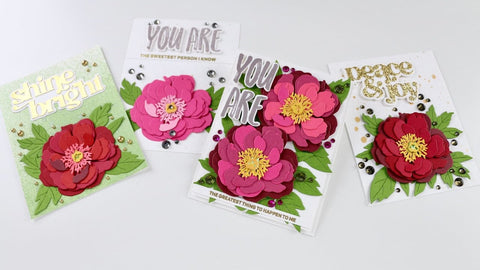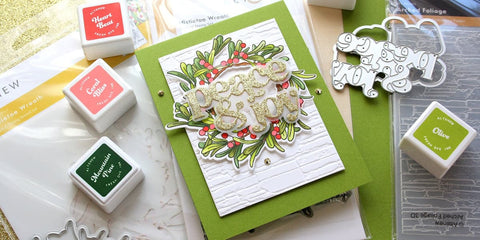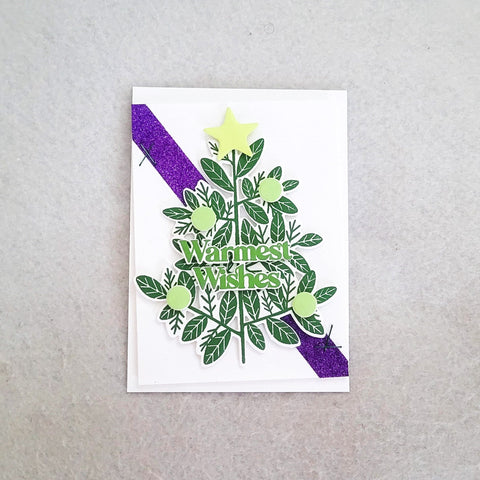Best Greeting Card Ideas for Beginner and Expert Cardmakers
Last Updated: October 27, 2025
Do you ever get in a crafting rut? You know, the one where you feel like you've tried all the cardmaking ideas out there and are just plain bored with your craft supplies? If so, this blog post is for you! Today we'll be exploring some fun and creative greeting card ideas that will help inspire your next project. From stamping needlework designs to some oldie-but-goodie masking, we've got something for everyone! So gather up your crafting supplies, and let's get started!
Best Greeting Card Ideas (Beginner-Friendly!)

You’ve probably heard of die-cut inlay… but have you heard of the embossed overlay technique? The die-cut inlay technique involves cutting a shape out of a panel and adhering the die-cuts back into the negative space for a unique 3D look. There are various ways to do this technique: partial in-lay, set-back in-lay, patterned paper in-lay, layered in-lay, etc.
The amazing Jaycee Gaspar took this technique to the next level! He shared how he was inspired by the die-cut inlay technique he first saw in one of Jennifer McGuire’s blog posts. Believe it or not, you only need three crafting supplies to recreate this cardmaking idea!
- Large Dies - Alphabet or Shape Dies
Watch the video below for a step-by-step on how to do an embossed overlay technique on your handmade card.

As the name suggests, ink smooshing is literally pressing (“smooshing”) your paper/die-cut onto a surface or palette with a wet coloring medium (watercolor, dye inks, alcohol inks, etc.) Our designer, Erum, took it to the next level by doing ink smooshing in all the colors of the rainbow! This is one of the easiest greeting card ideas you can try with the little ones.
Here’s how to do ink smooshing on cards:
- Heat emboss your chosen image in white embossing powder on A2 watercolor cardstock.
- Apply some dye inks (make sure to choose rainbow colors!) onto a watercolor palette. Then, use a mister to spray a bit of water on the inks and also on the watercolor card panel.
- Gently press the panel onto the inks and leave it for a couple of seconds. Pick it up and repeat it until you are satisfied. Dry the panel.
- Apply inks individually if there is more coverage of a particular color you are looking for.
- Once you’re happy with the look, you can die cut or fussy cut the images and adhere them to your card base.

3. Mask It Up!
Whether you’re a beginner or an expert card maker, you’ve probably come across the term “masking” in card making. This oldie-but-goodie card making technique is perfect for every crafter - regardless of the skill level. It doesn’t involve a lot of craft supplies, it’s quick and easy, and it’s an excellent way to stretch your supplies. This is one of the best greeting card ideas, especially if you’re into one-layer or CAS cards.
What is masking?
Masking is a technique that involves using “masks” to cover an image to create an illusion that one image is behind another.
Here’s how to do masking on cards:
- First, stamp an image onto your card panel.
- Stamp the same image onto masking paper, a piece of copy paper, or a sticky note. This will serve as your “mask.”
- Cut out the image or die cut it (if it has a coordinating die). Make sure to cut it precisely along the lines and avoid gaps.
- Place the “mask” on top of the stamped image on your card panel. Make sure it covers the stamped image entirely. If you’re not using masking paper, you can use masking or washi tape.
- Stamp onto your masked image. Feel free to be creative with the arrangement of images.
- Remove the mask and reveal your beautiful creation.
Watch the video below to see how Jenny did some clean and simple masking - 2 ways!

Vibrant Florals Hot Foil Plate & Stencil Bundle
If you think you’ve done all the ink blending techniques and ideas out there, think again! Have you tried ink blending on vellum? Yes, vellum! In this amazing cardmaking idea, Lydia blended ink on both sides of the vellum to see if it would create a different look.
Watch the video below to see how to do ink blending on vellum:
Ink blending is the art of blending two or more inks onto a surface and is often done to make a beautiful and seamless ombré effect. This is a popular technique used in mixed media art but has gained popularity in card making, scrapbooking, and even journaling.

At first, emboss resist might look like a complicated greeting card idea, but it’s completely beginner-friendly! This card making technique combines stamping, heat embossing, and coloring (with inks or watercolors). This helps you instantly create exciting and unique backgrounds or focal points. The heat-embossed image will “resist” the inks you add, giving you a crisp, shiny, embossed image that stands out against a gorgeous ink blended or watercolored background.
Here are the basics of emboss resist:
- First, stamp your chosen image using embossing ink.
- Next, add embossing powder to the stamped image (white and clear powder are great for this technique!).
- Use a heat tool to heat emboss.
- Once dry, add colors through ink blending or watercoloring.

Lagoon Metallic Shimmer Ink Spray
If you hate mess and cringe at the sight of a splatter of ink anywhere on your craft desk, then this card making idea may not be for you. Adding splatter to card designs is one of the best greeting card ideas you can easily try. It only requires a bit of practice and control. Virginia shared some tips on how not to be intimidated by the art of ink splattering!
- Tip #1: You can add ink splatter by using droplets of ink spray. Simply tap the spray tube gently all over the card panel.
- Tip #2: Try it out on a piece of scrap paper first! This will help you see how big or small the splatters you create are.
- Tip #3: You can also use a small paint brush for adding splatter. This is ideal if you use watercolor pigments or dye inks to add the splatter effect.

You read that right! If you’re both into card making and sewing - this is definitely one of the best greeting card ideas for you! Norine found a way to combine two of her passions into one uber-creative card design. She used the Pegboard Canvas Cover Die for her project, and because it has fewer and larger holes, this allowed her to use thicker strands of embroidery cotton and complete the project much more quickly. After stamping the flower image onto her card panel, she simply die cut it with the Pegboard Canvas Cover Die, and started cross stitching!

If you’re only starting out with card making, the spotlight technique is a must-try! As the name suggests, this technique involves spotlighting a portion of a stamped image. It’s a relatively easy card making idea that plays with colors to highlight a part (or parts) of an image. This is the perfect technique if you want an image to take center stage on your card.
Watch the video below to see how Lydia creatively combined two different stamp sets and used the spotlight technique.

Whimsical Peony Hot Foil Plate & Stencil Bundle
Although it’s not a new card making technique, hot foiling has taken the paper crafting world by storm. With the advent of hot foil plates with coordinating stamps, dies, and stencils, foiling has been the go-to technique for most crafters. It can give any project that extra oomph in just a few simple steps.
Believe it or not, it only took 3 steps to create Laurie’s stunning CAS card!
- Run the Peony Hot Foil Plate through the hot foil system using gold foil.
- Add additional colors using the coordinating stencil and a couple of dye inks.
- Add the die-cut sentiment!

Alcohol ink backgrounds are all the rage in the world of arts and crafts. But have you tried using your alcohol inks with gold mirror cardstock to create an elegant tarnished look?! The Gold Mirror Cardstock that Lydia used in her cards took the alcohol inks pretty well, creating an elegant and vintage vibe that is simply beautiful!

Read: Alcohol-Inked Larkspurs on Vellum
11. Mix and Match!
While there isn’t a card making technique involved in this last greeting card idea, this is definitely a must-try! Try to mix and match supplies if you’re looking for ways to stretch them or breathe a new life into your old faves. In her CAS card, Aga used a few products from different themes to create a one-of-a-kind design that you won’t find anywhere else!

Here’s how to recreate Aga’s CAS card:
- To create the background, she used a masking technique to mask off the edges of the card base.
- She then used Grid Stencil in the center of the card front and applied Misty Morning Crisp Dye Ink with a small ink blending tool.
- She used the Small World Die Set with green and black cardstock to create the floral globe.
- Then, she used the Itty Bitty Branches Die Set to cut some blossom and leaf branches out of white cardstock.
- She used the Artist Alcohol Markers Green Fields Set and pink markers from Sunshine Valley Garden Artist Alcohol Markers Set F to color the die-cuts and cut them into small pieces.
- To finish this thank you card, she stamped two sentiments, one from Thank You Builder Stamp Set and another one from the Thinking of You Stamp Set.

Read: How to Do Layered Marker and Pencil Coloring
Try These Creative Cardmaking Ideas Today!
Whether you’re just starting out in the world of cardmaking or have been at it for a while, these creative greeting card ideas will help you create beautiful and unique cards that showcase your personality and creativity. From simple designs that anyone can make in minutes to more intricate cards, we’ve got something for everyone. So, get out your craft supplies and have fun with these cardmaking ideas!
Drop by the All About Crafting page if you’re looking for more paper crafting tips, tricks, fun facts, and trivia. Stuck and don’t know what to write inside your handmade card? Take a look at our thoughtfully curated Greeting Card Messages here!




